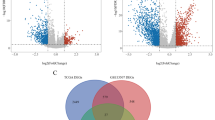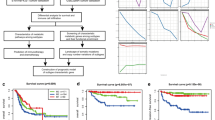Abstract
This study aims to develop fatty acid metabolism-related molecular subtypes and construct a fatty acid metabolism-related novel model for bladder cancer (BCa) by bioinformatic profiling. Genome RNA-seq expression data of BCa samples from the TCGA database and GEO database were downloaded. We then conducted consensus clustering analysis to identify fatty acid metabolism-related molecular subtypes for BCa. Univariate and multivariate Cox regression analysis were performed to identify a novel prognostic fatty acid metabolism-related prognostic model for BCa. Finally, we identified a total of three fatty acid metabolism-related molecular subtypes for BCa. These three molecular subtypes have significantly different clinical characteristics, PD-L1 expression levels, and tumor microenvironments. Also, we developed a novel fatty acid metabolism-related prognostic model. Patients with low-risk score have significantly preferable overall survival compared with those with high-risk score in the training, testing, and validating cohorts. The area under the ROC curve (AUC) for overall survival prediction was 0.746, 0.681, and 0.680 in the training, testing and validating cohorts, respectively. This model was mainly suitable for male, older, high-grade, cluster 2–3, any TCGA stage, any N-stage, and any T-stage patients. Besides, we selected FASN as a hub gene for BCa and further qRT-PCR validation was successfully conducted. In conclusion, we developed and successfully validated a novel fatty acid metabolism-related prognostic model for predicting outcome for BCa patients.










Similar content being viewed by others
Availability of data and materials
All data generated or analyzed during the present study was downloaded from TCGA database (https://portal.gdc.cancer.gov), GEO database (https://www.ncbi.nlm.nih.gov), and Molecular Signatures Database (MSigDB) (https://www.gsea-msigdb.org/gsea/msigdb).
References
Abdelrahman AE, Rashed HE, Elkady E, et al. 2019 Fatty acid synthase, Her2/neu, and E2F1 as prognostic markers of progression in non-muscle invasive bladder cancer. Ann. Diagn. Pathol. 39 42–52
Ben Fradj MK, Ouanes Y, Hadj-Taieb S, et al. 2018 Decreased oleic acid and marine n – 3 polyunsaturated fatty acids in Tunisian patients with urothelial bladder cancer. Nutr. Cancer 70 1043–1050
Bhanvadia SK 2018 Bladder cancer survivorship. Curr. Urol. Rep. 19 111
Bladder cancer: diagnosis and management of bladder cancer: © NICE 2015 Bladder cancer: diagnosis and management of bladder cancer 2017. BJU Int. 120 755–765
Chen JW, Dodia C, Feinstein SI, Jain MK, et al. 2000 1-Cys peroxiredoxin, a bifunctional enzyme with glutathione peroxidase and phospholipase A2 activities. J. Biol. Chem. 275 28421–28427
Chowdhury PS, Chamoto K, Kumar A, et al. 2018 PPAR-induced fatty acid oxidation in t cells increases the number of tumor-reactive CD8 (+) T cells and facilitates anti-PD-1 therapy. Cancer Immunol. Res. 6 1375–1387
Currie E, Schulze A, Zechner R, et al. 2013 Cellular fatty acid metabolism and cancer. Cell Metab. 18 153–161
Czimmerer Z, Varga T, Poliska S, et al. 2012 Identification of novel markers of alternative activation and potential endogenous PPARγ ligand production mechanisms in human IL-4 stimulated differentiating macrophages. Immunobiology 217 1301–1314
Dobruch J, Daneshmand S, Fisch M, et al. 2016 Gender and bladder cancer: a collaborative review of etiology, biology, and outcomes. Eur. Urol. 69 300–310
Gao L, Meng J, Yue C, et al. 2021 Integrative analysis the characterization of peroxiredoxins in pan-cancer. Cancer Cell Int. 21 366
Goller L, Bergstrom M, Nilsson S, et al. 1995 Mao-a enzyme binding in bladder-cancer characterized with [C-11] harmine in frozen-section autoradiography. Oncol. Rep. 2 717–721
Jeong H, Oh HE, Kim H, et al. 2021 Upregulation of fatty acid transporters is associated with tumor progression in non-muscle-invasive bladder cancer. Pathol. Oncol. Res. 27 594705
Jiang F, Luo F, Zeng N, et al. 2022 Characterization of fatty acid metabolism-related genes landscape for predicting prognosis and aiding immunotherapy in glioma patients. Front. Immunol. 13 902143
Joseph A, Juncheng P, Mondini M, et al. 2021 Metabolic features of cancer cells impact immunosurveillance. J. Immunother. Cancer 9 e002362
Ke ZB, Wu YP, Huang P, et al. 2020 Identification of novel genes in testicular cancer microenvironment based on ESTIMATE algorithm-derived immune scores. J. Cell Physiol. 236 706–713
Lenis AT, Lec PM, Chamie K, et al. 2020 Bladder cancer: A review. JAMA 324 1980–1991
Liberti MV and Locasale JW 2016 The Warburg effect: how does it benefit cancer cells? Trends Biochem Sci. 41 211–218
Luo Y, Wang H, Liu B, et al. 2022 Fatty acid metabolism and cancer immunotherapy. Curr. Oncol. Rep. 24 659–670
Mancini R, Noto A, Pisanu ME, et al. 2018 Metabolic features of cancer stem cells: the emerging role of lipid metabolism. Oncogene 37 2367–2378
Martinez Rodriguez RH, Buisan Rueda O and Ibarz L 2017 Bladder cancer: Present and future. Med. Clin. 149 449–455
McConkey DJ and Choi W 2018 Molecular subtypes of bladder cancer. Curr. Oncol. Rep. 20 77
Mou Z, Yang C, Zhang Z, et al. 2020 Transcriptomic analysis of glycolysis-related genes reveals an independent signature of bladder carcinoma. Front. Genet. 11 566918
Scheiter A, Evert K, Reibenspies L, et al. 2022 RASSF1A independence and early galectin-1 upregulation in PIK3CA-induced hepatocarcinogenesis: new therapeutic venues. Mol. Oncol. 16 1091–1118
Su YL, Luo HL, Huang CC, et al. 2020 Galectin-1 overexpression activates the FAK/PI3K/AKT/mTOR pathway and is correlated with upper urinary urothelial carcinoma progression and survival. Cells 9 806
Tao T, Su Q, Xu S, et al. 2019 Down-regulation of PKM2 decreases FASN expression in bladder cancer cells through AKT/mTOR/SREBP-1c axis. J. Cell Physiol. 234 3088–3104
Vantaku V, Dong J, Ambati CR, et al. 2019 Multi-omics integration analysis robustly predicts high-grade patient survival and identifies CPT1B effect on fatty acid metabolism in bladder cancer. Clin. Cancer Res. 25 3689–3701
Vasekar M, Degraff D and Joshi M 2016 Immunotherapy in bladder cancer. Curr. Mol. Pharmacol. 9 242–251
Warrick JI, Al-Ahmadie H, Berman DM, et al. 2023 International Society of Urological Pathology Consensus Conference on Current Issues in Bladder Cancer. Working Group 4: Molecular Subtypes of Bladder Cancer-Principles of Classification and Emerging Clinical Utility. Am. J. Surg. Pathol. 10-1097
Xiong Q, Feng D, Wang Z, et al. 2022 Fatty acid synthase is the key regulator of fatty acid metabolism and is related to immunotherapy in bladder cancer. Front. Immunol. 13 836939
Xu N, Ke ZB, Lin XD, et al. 2020 Development and validation of a molecular prognostic index of bladder cancer based on immunogenomic landscape analysis. Cancer Cell Int. 20 302
Funding
Not applicable.
Author information
Authors and Affiliations
Contributions
Writing – original draft, W-T S. Writing – review and editing, YW, NX. Methodology, QH, J-B S, J-Y C. Investigation, Z-B K, S-H C. Formal analysis, Y-Z L, X-Y X. Data curation, QH, J-B S. Conceptualization, Z-B K, S-H C. Visualization, Y-Z L, X-Y X. Supervision, YW, NX, X-Y X. Project administration, W-T S, S-H C.
Corresponding authors
Ethics declarations
Conflict of interests
All authors declare no conflict of interests.
Additional information
Corresponding editor: Ram Rajasekharan
Rights and permissions
Springer Nature or its licensor (e.g. a society or other partner) holds exclusive rights to this article under a publishing agreement with the author(s) or other rightsholder(s); author self-archiving of the accepted manuscript version of this article is solely governed by the terms of such publishing agreement and applicable law.
About this article
Cite this article
Su, WT., Chen, JY., Sun, JB. et al. Fatty acid metabolism-related molecular subtypes and a novel model for predicting prognosis in bladder cancer patients. J Biosci 49, 11 (2024). https://doi.org/10.1007/s12038-023-00383-x
Received:
Accepted:
Published:
DOI: https://doi.org/10.1007/s12038-023-00383-x




